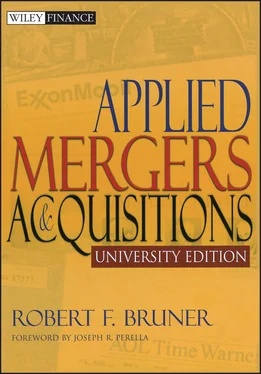There are 16 studies that consider returns well after the consummation of the transaction (see Exhibit 3.6). Eleven of these studies report negative and significant returns. Caves (1989) infers that these findings are due to “second thoughts” by bidders’ shareholders, and/or the release of new information about the deal. But interpretation of longer-run returns following the transaction is complicated by possibly confounding events that have nothing to do with the transaction. Consistent with this, two streams of recent research suggest plausible explanations for the postmerger declines. The first is overvaluation of the buyer’s shares; Shleifer and Vishny (2001) suggest that buying firms tend to acquire with stock when they believe their shares are overvalued. Thus, the postmerger decline is not a reflection of the success of the merger, but rather a correction in the market’s valuation of the buyer. The second is the effect of industry shocks. Mitchell and Mulherin (1996) argue that the poor performance following acquisition is often the signal of economic turbulence in the industry rather than the acquisition itself. More is said about both theories in Chapters 4and 20.
When the welfare of creditors and stockholders in the buyer firm are considered, three studies suggest that the value of the buyer firm increases by a statistically significant amount. 7 This suggests that the gains from acquisition are not isolated to stockholders.
A reasonable conclusion from these studies is that in the aggregate, abnormal (or market-adjusted) returns to buyer shareholders from M&A activity are essentially zero. Buyers basically break even (i.e., acquisitions tend to offer zero net present values, or, equivalently, investors earn their required return).
Any inferences about the typical returns to buyers based on returns must grapple with the difficult issue of the size difference between buyers and targets. Buyers are typically much larger than targets. Thus, even if the dollar gains from merger were divided equally between the two sides, the percentage gain to the buyer’s shareholders would be smaller than to the target’s. Asquith, Bruner, and Mullins (1983) reported results consistent with the size effect. For instance, in mergers where the target’s market value was equal to 10 percent or more of the buyer’s market value, the return to the buyer was 4.1 percent (t = 4.42). But where the target’s value was less than 10 percent, the return to the buyer was only 1.7 percent. Numerous other studies have confirmed the significance of the relative size of the target in explaining variations in returns. The practical implication of this is that the impact of smaller deals (which constitute the bulk of M&A activity) gets lost in the noise . In other words, what we know about M&A profitability is a blend of noise and large deals.
Returns to Buyer and Target Firms Combined
Findings of positive abnormal returns to the seller and breakeven returns to the buyer raise the question of net economic gain from this event. The challenge here stems from the size difference between buyer and target: typically, the buyer is substantially larger. Hence, a large percentage gain to the target shareholders could be more than offset by a small percentage loss to the buyer shareholders. A number of studies have examined this by forming a portfolio of the buyer and target firms and examining either their weighted average returns (weighted by the relative sizes of the two firms) or by examining the absolute dollar value of returns. Exhibit 3.7reports the findings of 24 studies. Almost all of the studies report positive combined returns, with 14 of the 24 being significantly positive. The findings suggest that M&A does pay the investors in the combined buyer and target firms.
EXHIBIT 3.6 Studies Reporting Long-Term Returns to Acquirers
| Study |
Cumulative Abnormal Returns |
Sample Size |
Sample Period |
Event Window (Days) |
% Positive Returns |
Notes |
| Mandelker (1974) |
–1.32% successful bids only |
241 |
1941–1963 |
(0,365) |
N/A |
Mergers only. Event date is date of consummation of the deal. |
| Dodd, Ruback (1977) |
–1.32% successful –1.60% unsuccessful |
124 48 |
1958–1978 |
(0,365) |
N/A |
Tender offers only. Event date is date of offer. |
| Langetieg (1978) |
–6.59% *successful bids only |
149 |
1929–1969 |
(0,365) |
N/A |
Mergers only. |
| Asquith (1983) |
–7.20% *successful |
196 |
1962–1976 |
(0,240) |
N/A |
Mergers only. |
|
–9.60% *unsuccessful |
89 |
|
|
|
|
| Bradley, Desai, Kim (1983) |
–7.85% *unsuccessful bids only |
94 |
1962–1980 |
(0,365) |
N/A |
Tender offers only. |
| Malatesta (1983) |
–2.90% whole sample –13.70% *after l970 |
121 75 |
1969–1974 |
(0,365) |
N/A |
Mergers only. Event date is date of approval. |
|
–7.70% smaller bidders |
59 |
|
|
|
|
| Agrawal, Jaffe, Mandelker (1992) |
–10.26% * |
765 |
1955–1987 |
(0,1,250) |
43.97% |
Mergers only; five-year postmerger performance; tender offer postacquisition performance is not significantly different from zero. |
| Loderer, Martin (1992) |
+1.5% |
1,298 |
1966–1986 |
(0,1,250) |
N/A |
Mergers and tender offers; five-year postacquisition performance. |
| Gregory (1997) |
–12% to –18% * |
452 |
1984–1992 |
(0,500) |
31% to 37% |
Uses six variations of the event study methodology; U.K. mergers and tender offers; two-year postacquisition performance. |
| Loughran, Vijh (1997) |
–14.2% merger +61.3% *tender |
434 100 |
1970–1989 |
(1,1,250) |
N/A |
Five-year postacquisition returns; segment data also available on form of payment. |
|
–0.1% combined |
|
|
|
|
|
| Rau, Vermaelen (1998) |
–4% *mergers +9% *tender offers |
3,968 348 |
1980–1991 |
(0,36 months) |
N/A |
Three-year postacquisition returns, with insights into value and glamour investing strategies. |
| Louis (undated) |
–7.3% *successful –18.4% *unsuccessful |
1,297 308 |
1981–1998 |
(0,3 years) |
N/A |
Comparison of successful and unsuccessful acquirers. |
| Pettit (2000) |
–25.41% * |
216 |
1977–1993 |
(0,3 years) |
N/A |
Tender offers, French sample. |
| Ferris and Park (2001) |
–19.80% * |
56 |
1990–1993 |
(l,+60 months) |
N/A |
Sample of mergers in the telecommunications industry. |
| Kohers, Kohers (2001) |
–37.39% |
304 |
1984–1995 |
(1,1,250) |
N/A |
Sample of technology mergers. |
| Moeller, Schlingemann, Stulz (2003) |
–4.1% |
12,023 |
1980–2001 |
(0,36 months) |
N/A |
|
Unless otherwise noted, event date is announcement date of merger/bid.
*Significant at the 0.95 confidence level or better.
FINDINGS BASED ON THE ANALYSIS OF REPORTED FINANCIAL PERFORMANCE
A second important stream of research on M&A returns is found in 15 studies of profit margins, growth rates, and returns on assets, capital, and equity, summarized in Exhibit 3.8. Scanning the column of results yields the observation that two studies report significantly negative performance postacquisition, four report significantly positive performance, and the rest are in the nonsignificant middle ground. Four studies illuminate interesting aspects of postacquisition performance.
Читать дальше












